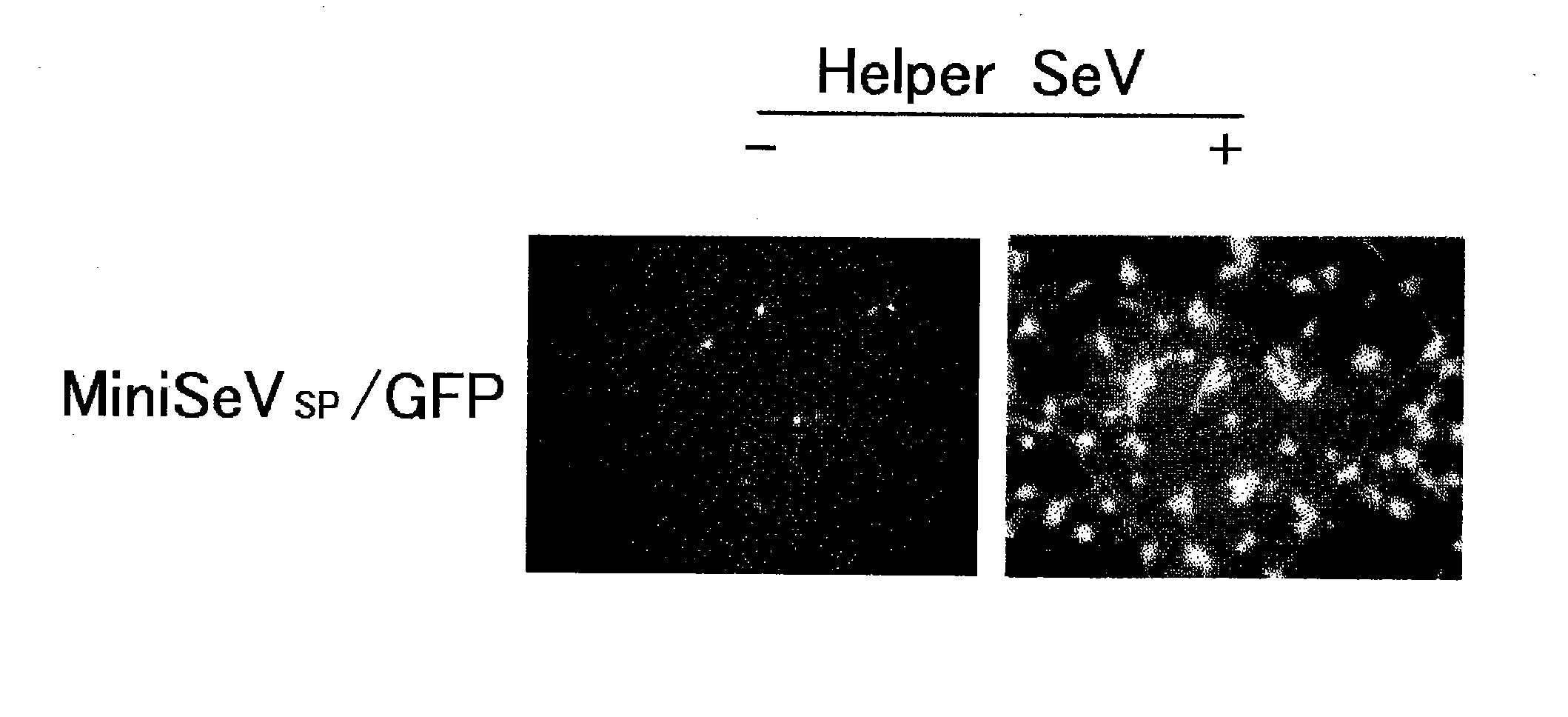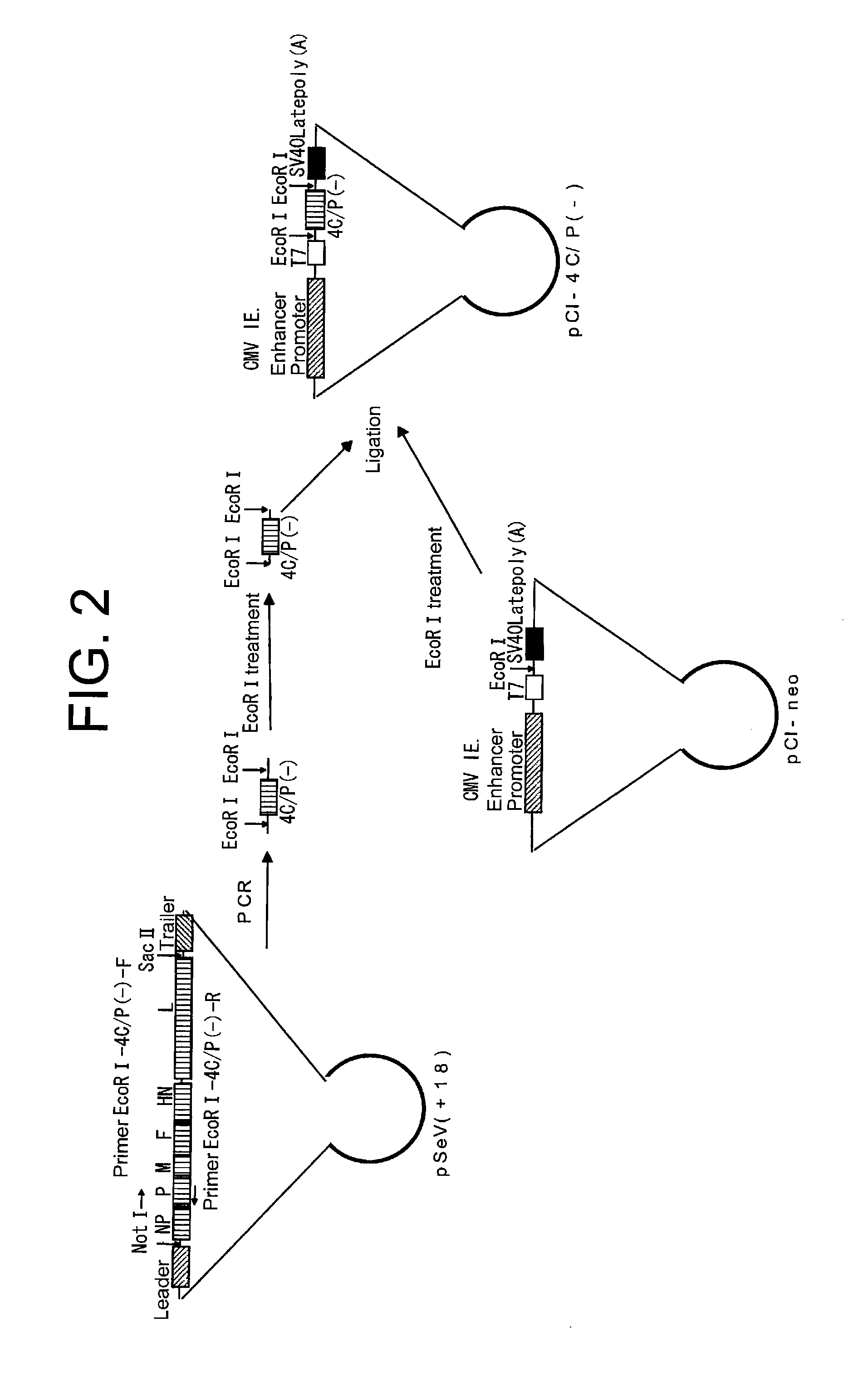Non-replicating paramyxoviridae virus vector
a paramyxoviridae virus and vector technology, applied in the field of non-replicating paramyxoviridae virus vectors, can solve the problem of not reporting on the production of l gene-deficient vectors for paramyxoviridae virus vectors, and achieve the effects of simple operation, enhanced effect and high versatility
- Summary
- Abstract
- Description
- Claims
- Application Information
AI Technical Summary
Benefits of technology
Problems solved by technology
Method used
Image
Examples
example 1
Effect of the SeV C Protein on the Productivity of MiniSeV / GFP / M / F / HN
[0117]Using the Lipofectamine 2000 reagent, pCAGGS-NP (Z), pCAGGS-P (Z) / 4C(−), pCAGGS-L (TDK), and pCI control or pCI-4C / P(−) were introduced into BHK-21 cells, which were plated at 2e5 cells / well (12-well collagen-coated plate, IWAKI) on the previous day. On the next day, the cells were infected with MiniSeV / GFP / M / F / HN as a seed virus. Then, virus production was performed using VP-SFM medium containing trypsin (at a final concentration of 2.5 μg / ml). GFP fluorescence in production cells was photographed four days after infection. Furthermore, the culture supernatant was collected on day four, and fresh LLC-MK2 cells were infected with the virus (24-well plate). GFP fluorescence was photographed three days after infection.
[0118]Higher virus productivity was achieved under the conditions in which the C protein expression plasmid [pCI-4C / P(−)] was introduced, as compared to the conditions in which the control plasmid...
example 2
Production of MiniSeV / GFP / M / F / HN
[0119]Using the Lipofectamine 2000 reagent, pCAGGS-NP (Z), P (Z) / 4C(−), L (TDK), and pCI-4C / P(−) were introduced into BHK-21 cells, which were plated at 8e5 cells / well (6-well collagen-coated plate, IWAKI) on the previous day. On the next day, the cells were infected with MiniSeV / GFP / M / F / HN as a seed virus. Then, virus production was performed using VP-SFM medium containing trypsin (at a final concentration of 2.5 μg / ml). Every day during the period of one to seven days after infection, GFP fluorescence was photographed, the culture supernatant was collected, and the medium was exchanged. CIU assay was carried out using the culture supernatants collected from day one to day seven.
[0120]As shown in FIG. 4, MiniSeV / GFP / M / F / HN with a very high titer of 1e7 GFP-CIU / ml or more was collected from the day-3 to day-6 culture supernatants.
example 3
In Vitro Expression using MiniSeV / GFP / M / F / HN
[0121]HeLa cells, which were plated at 3e5 cells / well (12-well collagen-coated plate, IWAKI) on the day of infection, were infected with MiniSeV / GFP / M / F / HN at an MOI of 100, 10, or 1. On the other hand, HeLa cells were co-infected with MiniSeV / GFP / M / F / HN at MOI 1 and SeVagp55 / dF at MOI 5. GFP fluorescence was photographed one and two days after infection.
[0122]As shown in FIG. 5, only weak GFP expression was observed when the cells were infected with MiniSeV / GFP / M / F / HN alone at MOI 1; however, when the cells were infected at MOI 100, the GFP expression level was confirmed to be closer to the level when Helper SeV (SeVagp55 / ΔF) was co-transfected (equivalent to a replicative SeV).
PUM
| Property | Measurement | Unit |
|---|---|---|
| Immunogenicity | aaaaa | aaaaa |
Abstract
Description
Claims
Application Information
 Login to View More
Login to View More - R&D
- Intellectual Property
- Life Sciences
- Materials
- Tech Scout
- Unparalleled Data Quality
- Higher Quality Content
- 60% Fewer Hallucinations
Browse by: Latest US Patents, China's latest patents, Technical Efficacy Thesaurus, Application Domain, Technology Topic, Popular Technical Reports.
© 2025 PatSnap. All rights reserved.Legal|Privacy policy|Modern Slavery Act Transparency Statement|Sitemap|About US| Contact US: help@patsnap.com



